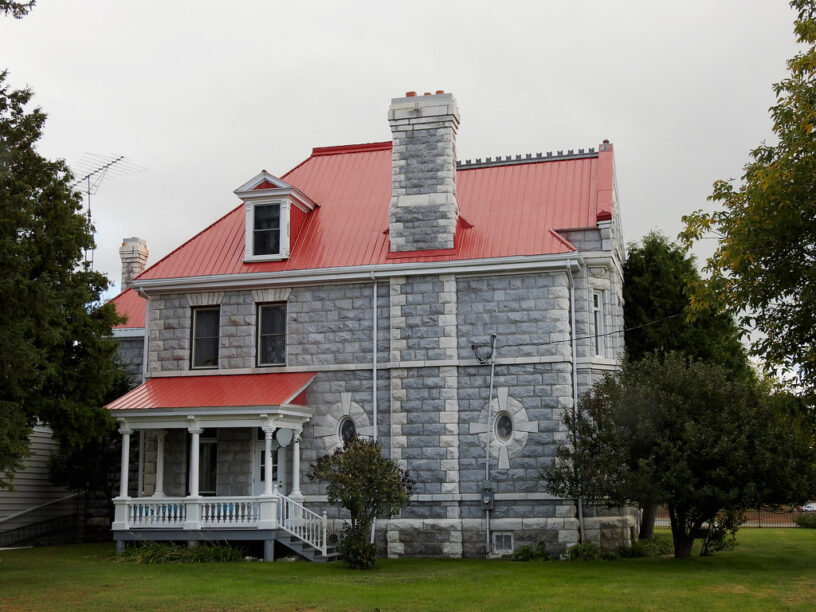Living in a 120-year-old house can have its benefits – and its drawbacks. Just ask Linda Vowels and her husband Ross, who for the past 14 years have lived in the grand old stone house on the corner of 303 and 301 in Portage du Fort.
The house has been in our family for over 30 years,” said Linda. “My parents, Edgar and Eleanor Connelly bought it around 1981.” The Connellys were better known, at the time, for owning the motel and restaurant in Shawville, Ed and Ellen’s as it was often called.
“This house has had many lives,” said Linda when asked how many different owners it had. “It was originally built for a wealthy family, then it became a boarding house, there was once a hairdresser here and, I believe it was also a foster home.”
Today the house is simply home to the couple who live there with Mrs Connelly, Linda’s mother. Her father, Edgar, died in 2006.
Mr Connelly was a lover of antiques, so the house suited him just fine. There were so many rooms to fill – nine bedrooms, a dining room, great room, kitchen and sitting room. He spent his time scouring antique places and auctions for treasures to bring home to the Chateau du Pontiac.
Mrs. Connelly had a natural flair for decorating and welcomed her husband’s finds. She pondered the right curtains and paint colour to brighten the rooms and arranged his priceless antiques to suit the decor. Every room in the old house has its own character.
There is an elegant bedroom on the second floor with a beautiful old bed frame that is original to the house. A patchwork quilt on the bed commemorates Canada’s Centennial with 1867 – 1967 embroidered in the center. The whimsical patchwork is embroidered with the names of the provinces. A delicate antique washstand holds a basin and water pitcher, lending authenticity to the scene.
A visit to the house is both educational and extraordinary. Its craftmanship is like nothing built in recent days and its features.
Mr. George Emmerson Reid built the house in 1899. He was a wealthy lumberman and businessman, young and ambitious. It was a very different time in Portage. There were more than 1,200 residents of the small village and an equal number of transients, mostly lumbermen and traders, coming and going. There were two banks, numerous taverns, a tailor shop, brickyard, a lime kiln, post office and a marble quarry that supplied the cornerstones for the Parliament Buildings. The first district newspaper was published there, the Pontiac Pioneer.
Reid built the house for his wife, Louisa Margaret Amy. They prospered there raising six children: three boys and three girls. The high life came to an abrupt halt in 1914 when fire ravaged the town and destroyed the majority of the homes and businesses. Edgewood and the other stone houses remained, but the town that was once the commercial center of the Pontiac was doomed. The Canadian Northern Railway was built soon after and bypassed Portage.
Reid lived in the home until his death in 1936. He was heavily involved in local politics and was once the Mayor. After his death, Mrs Reid only lived there in the summertime preferring to spend the winters at the White House Inn in Renfrew. She died in 1956.
Portage rose again in the 1950s when the Chenaux power plant and dam were built. Thousands of men men descended on the tiny village needing a place to rest and get a good meal. The house sold and became a boarding house for the workers. The numbers 1 – 9 remain on the doors of each of the upstairs bedrooms as evidence of the homes purpose in those times.
“There have been a number of different owners,” said Linda. “Over that 30-year period it changed hands a few times. There was a Mr. Brazeau, Mr. David, maybe Terry Murdoch.”
A portrait that is thought to be of Mr. Reid as a young man has hung by the front door for years watching all those people coming and going.
When asked if she still considers the house to be the Reid house (the Connelly have now owned it for almost 31 years) Linda said, “It will always be the Reid’s. We are just the keepers of the house.”
If the walls could talk, perhaps they would say “Thank You” to Linda and Ross for keeping the house and its splendid history alive for all these years.





Leave a Reply